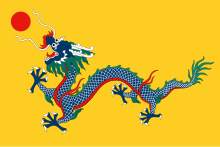| Military of the Qing dynasty | |
|---|---|
 Flag of the Qing dynasty (1889-1912) | |
 The Qianlong Emperor's Southern Inspection Tour, Scroll Twelve: Return to the Palace (detail), 1764–1770, by Xu Yang | |
| Founded | c. 1644 |
| Disbanded | c. 1912 |
| Service branches | |
| Leadership | |
| Emperor | Xuantong (last) |
| Minister of War | Wang Shizhen (last) |
| Minister of the Navy | Sa Zhenbing (last) |
| Personnel | |
| Active personnel | 800,000 personnels |
| Related articles | |
| Ranks | Military ranks of Imperial China |

The Qing dynasty (1644–1912) was established by conquest and maintained by armed force. The founding emperors personally organized and led the armies, and the continued cultural and political legitimacy of the dynasty depended on their ability to defend the country from invasion and expand its territory. Military institutions, leadership, and finance were fundamental to the dynasty's initial success and ultimate decay. The early military system centered on the Eight Banners, a hybrid institution that also played social, economic, and political roles.[1]
The use of gunpowder during the High Qing can compete with the three gunpowder empires in western Asia.[2] However, The military technology of the European Industrial Revolution made China's armament and military rapidly obsolete. By the middle of the 18th century, the military of the Qing dynasty numbered over 200,000 bannermen and 600,000 Green Standard troops.[3]
The Qing navy became the largest in East Asia, but its organization and logistics were inadequate, officer training was deficient, and corruption widespread. The Beiyang Fleet was virtually destroyed and the modernized ground forces defeated in the 1895 First Sino-Japanese War. The Qing created a New Army, but could not prevent the Eight Nation Alliance from invading China to put down the Boxer Uprising in 1900. The revolt of a New Army corps in 1911 led to the fall of the dynasty.
- ^ Elliott 2001, p. 40.
- ^ Millward 2007, p. 95.
- ^ Yingcong Dai (12 July 2017). "QING MILITARY INSTITUTIONS AND THEIR EFFECTS ON GOVERNMENT, ECONOMY, AND SOCIETY, 1640–1800". Journal of Chinese History. 1 (2). Cambridge University Press: 329–352. doi:10.1017/jch.2017.1. Retrieved 3 December 2023.
By the middle of the eighteenth century, the total number of Qing military forces may have reached 800,000 (200,000 bannermen, and 600,000 Green Standard troops); Ergang, Luo 羅爾綱, Lüying bingzhi 綠營兵制 (Beijing: Zhonghua shuju, 1984), 7–9 Google Scholar.